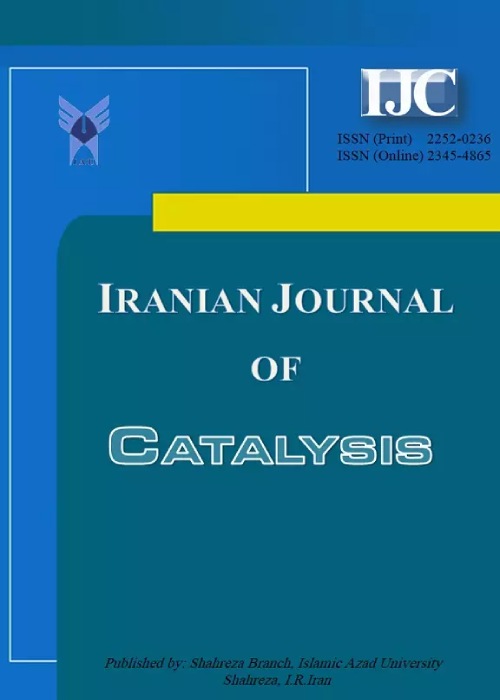فهرست مطالب
Iranian Journal of Catalysis
Volume:1 Issue: 1, Spring 2011
- تاریخ انتشار: 1390/08/17
- تعداد عناوین: 8
-
-
Pages 1-9A convenient and efficient procedure for the synthesis of 14-aryl or alkyl-14H-dibenzo[a,j]xanthenes by condensation of 2-naphthol and aldehydes in the presence of Methylimidazolium hydrogensulfate, as a Brönsted acidic ionic liquid ([Hmim]HSO4), is described. Both aromatic and aliphatic aldehydes reacted easily to afford the corresponding 14-aryl or alkyl-14H-dibenzo[a,j]xanthenes in good yields under solvent-free conditions. Moreover, the synthesis of 1-amidoalkyl 2-naphthols is studied by condensation of aromatic aldehydes with amides or urea and 2-naphthol in the presence of [Hmim]HSO4. Using solvent-free conditions, non-toxic and inexpensive materials, simple and clean work-up, short reaction times and high yields of the products are the advantages of this methodKeywords: Methylimidazolium hydrogen sulfate, Dibenzoxanthene, Amidoalkyl naphthols, 2, Naphthol, Aldehyde
-
Pages 11-17Tetrahy dropyranylation of alcohols and phenols, acetylation of aldehydes and N-Boc protection of amines are efficiently catalyzed by melamine trisulfonic acid (MTSA). All reactions were performed at room temperature in good to high yields.Keywords: Melamine trisulfonic acid, Alcohols, Phenols, Aldehydes, Amines
-
Pages 19-23The aerobic oxidation of alcohols was efficiently completed in high conversion and selectivity using Cu3/2[PMo12O40]/SiO2 as catalyst under mild reaction condition. This reaction provides a new environmentally friendly rout to the conversion of alcoholic function to carbonyl groups.Keywords: Green chemistry, aerobic alcohol oxidation, polyoxometalates (POMs)
-
Pages 25-29A facile and efficient method for the preparation of 1,1-diacetates of aldehydes is improved. The acidified kaolin with sulfuric acid (2 % w/w) catalyzed 1,1- diacetates formation from aldehydes in solvent-free conditions. Both aromatic and aliphatic aldehydes gave high yields (85-95 %) of the corresponding 1, 1- diacetates. Advantages of this method are the use of inexpensive and selective catalyst, with high yields in simple operat ion, and short reaction time under solvent-free conditions.Keywords: 1, 1, Diacetates, Kaolin, Protection, Solvent, free
-
Pages 31-361,1’-(Ethane-1,2-diyl)dipyridinium bistribromide (EDPBT) was used as a chemoselective and effective organocatalyst for the silylation of hydroxyl groups as well as desilylation of trimethylsilyl ethers under mild conditions at room temperature with good to excellent yields.Keywords: Silylation, Hydroxyl group, 1, 1', (Ethane, 1, 2, diyl)dipyridinium bistribromide, Trimethylsilyl ethers, Desilylation
-
Pages 37-40The esterification of free fatty acids (FFA) with methanol is studied using Sulfonated Porous Carbon (SPC) as catalyst. In compare to the amorphous sugar catalyst and protonated Nafion, the proposed catalyst shows stability and high efficient performance in biodiesel production. The highest initial rate of oleic acid conversion is obtained at catalyst loading of 1 mmol H+ and mole ratio of MeOH/Oleic acid of 10. The prepared Sulfonated Porous Carbon reused at least three times without loss of activity.Keywords: Sulfonated Porous Carbon, Esterification, Fatty acids, Solid acid
-
Pages 41-44Mn doped ZnO nanocomposite thin film coated on glass by a simple spin-coating method was used to degrade an azo textile dye from aqueous environment. Mn doped ZnO nanocomposite thin film was characterized by means of X-ray diffraction (XRD) and scanning electron microscopy (SEM). The photo- reduction activity of photocatalyst was evaluated using an azo textile dye as organic contaminant irradiated only with UV light from mercury bulb. The processing parameter such as the pH value also played an important role in tuning the photocatalytic activity. The maximum photodecomposition rate was achieved at pH=6, and a novel model about the absorption of azo dye on the surface of the catalysts was proposed.Keywords: Photocatalytic degradation, Mn doped ZnO thin film, Composite thin film, Nanoparticle, Azo dye
-
Pages 45-50Immobilization of catalysts on the surface of some inert supports makes therecovering step easier. Because of the specific physicochemical properties, zeolites are good candidate as catalyst supports. In this study, zeolite X was synthesized by natural kaolin and TiO2 was incorporated into zeolite phase by impregnation method. Degradation of Safranin Orange, methylene blue and 2,4–dinitroaniline was studied in the presence and absence of ultraviolet radiation. The effect of experimental parameters including TiO2 loading,photocatalyst amount, irradiation time, pH and initial concentration were studied. Adsorption and photodegradation of the pollutants followed first–order kinetics.Adsorption isotherms were analysed using Langmuir and Freundlich models. The higher activity obtained for TiO2supported onzeolite X is attributed to the greater adsorption of the pollutants on the zeolite surface as compared to pure TiO2.Keywords: TiO2–zeolite X, Photodegradation, Adsorption, Safranin Orange, Methylene blue, 2, 4–dinitroaniline


